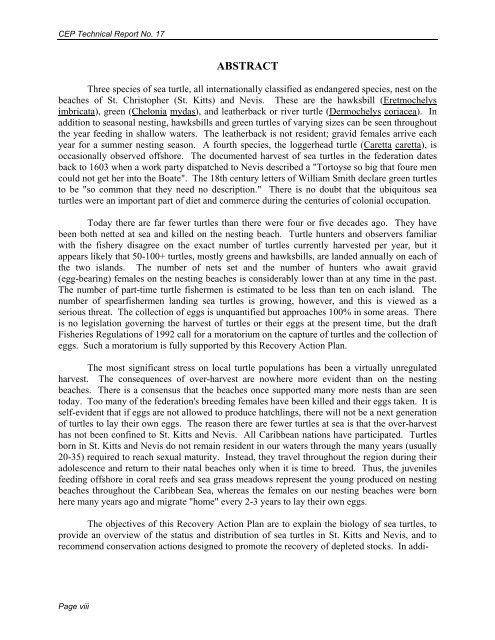Sea Turtle Recovery Action Plan for St. Kitts and Nevis - WIDECAST
Sea Turtle Recovery Action Plan for St. Kitts and Nevis - WIDECAST
Sea Turtle Recovery Action Plan for St. Kitts and Nevis - WIDECAST
Create successful ePaper yourself
Turn your PDF publications into a flip-book with our unique Google optimized e-Paper software.
CEP Technical Report No. 17<br />
ABSTRACT<br />
Three species of sea turtle, all internationally classified as endangered species, nest on the<br />
beaches of <strong>St</strong>. Christopher (<strong>St</strong>. <strong>Kitts</strong>) <strong>and</strong> <strong>Nevis</strong>. These are the hawksbill (Eretmochelys<br />
imbricata), green (Chelonia mydas), <strong>and</strong> leatherback or river turtle (Dermochelys coriacea). In<br />
addition to seasonal nesting, hawksbills <strong>and</strong> green turtles of varying sizes can be seen throughout<br />
the year feeding in shallow waters. The leatherback is not resident; gravid females arrive each<br />
year <strong>for</strong> a summer nesting season. A fourth species, the loggerhead turtle (Caretta caretta), is<br />
occasionally observed offshore. The documented harvest of sea turtles in the federation dates<br />
back to 1603 when a work party dispatched to <strong>Nevis</strong> described a "Tortoyse so big that foure men<br />
could not get her into the Boate". The 18th century letters of William Smith declare green turtles<br />
to be "so common that they need no description." There is no doubt that the ubiquitous sea<br />
turtles were an important part of diet <strong>and</strong> commerce during the centuries of colonial occupation.<br />
Today there are far fewer turtles than there were four or five decades ago. They have<br />
been both netted at sea <strong>and</strong> killed on the nesting beach. <strong>Turtle</strong> hunters <strong>and</strong> observers familiar<br />
with the fishery disagree on the exact number of turtles currently harvested per year, but it<br />
appears likely that 50-100+ turtles, mostly greens <strong>and</strong> hawksbills, are l<strong>and</strong>ed annually on each of<br />
the two isl<strong>and</strong>s. The number of nets set <strong>and</strong> the number of hunters who await gravid<br />
(egg-bearing) females on the nesting beaches is considerably lower than at any time in the past.<br />
The number of part-time turtle fishermen is estimated to be less than ten on each isl<strong>and</strong>. The<br />
number of spearfishermen l<strong>and</strong>ing sea turtles is growing, however, <strong>and</strong> this is viewed as a<br />
serious threat. The collection of eggs is unquantified but approaches 100% in some areas. There<br />
is no legislation governing the harvest of turtles or their eggs at the present time, but the draft<br />
Fisheries Regulations of 1992 call <strong>for</strong> a moratorium on the capture of turtles <strong>and</strong> the collection of<br />
eggs. Such a moratorium is fully supported by this <strong>Recovery</strong> <strong>Action</strong> <strong>Plan</strong>.<br />
The most significant stress on local turtle populations has been a virtually unregulated<br />
harvest. The consequences of over-harvest are nowhere more evident than on the nesting<br />
beaches. There is a consensus that the beaches once supported many more nests than are seen<br />
today. Too many of the federation's breeding females have been killed <strong>and</strong> their eggs taken. It is<br />
self-evident that if eggs are not allowed to produce hatchlings, there will not be a next generation<br />
of turtles to lay their own eggs. The reason there are fewer turtles at sea is that the over-harvest<br />
has not been confined to <strong>St</strong>. <strong>Kitts</strong> <strong>and</strong> <strong>Nevis</strong>. All Caribbean nations have participated. <strong>Turtle</strong>s<br />
born in <strong>St</strong>. <strong>Kitts</strong> <strong>and</strong> <strong>Nevis</strong> do not remain resident in our waters through the many years (usually<br />
20-35) required to reach sexual maturity. Instead, they travel throughout the region during their<br />
adolescence <strong>and</strong> return to their natal beaches only when it is time to breed. Thus, the juveniles<br />
feeding offshore in coral reefs <strong>and</strong> sea grass meadows represent the young produced on nesting<br />
beaches throughout the Caribbean <strong>Sea</strong>, whereas the females on our nesting beaches were born<br />
here many years ago <strong>and</strong> migrate "home" every 2-3 years to lay their own eggs.<br />
The objectives of this <strong>Recovery</strong> <strong>Action</strong> <strong>Plan</strong> are to explain the biology of sea turtles, to<br />
provide an overview of the status <strong>and</strong> distribution of sea turtles in <strong>St</strong>. <strong>Kitts</strong> <strong>and</strong> <strong>Nevis</strong>, <strong>and</strong> to<br />
recommend conservation actions designed to promote the recovery of depleted stocks. In addi-<br />
Page viii
















